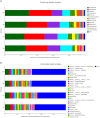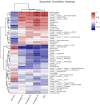Effects of microbial agent application on the bacterial community in ginger rhizosphere soil under different planting years
- PMID: 37744902
- PMCID: PMC10516606
- DOI: 10.3389/fmicb.2023.1203796
Effects of microbial agent application on the bacterial community in ginger rhizosphere soil under different planting years
Abstract
Ginger is one of the important spice crops in the world. Due to the prevalence of ginger wilt disease and the lack of effective prevention and control methods, the planting area, total production and value have declined sharply, which have become a key factor restricting ginger industry development in China. Understanding the influence of microbial agents on the rhizosphere microbiota of ginger will facilitate developing novel technologies for the prevention and control of ginger wilt disease. In the new planting and continuous cropping ginger fields, using large-root ginger and microbial agents, two inoculation levels (inoculation and no inoculation) were designed, and high-throughput sequencing technology was used to study the bacterial community structure in the rhizosphere soil at mature stage of ginger. The results showed that newly planted ginger showed a significant yield advantage over continuous cropping ginger, with a yield increase of 39% to 56%, and the lowest ginger wilt disease index. The community structure at the phylum level of soil bacteria in each treatment was very similar to that in the control, but the abundance of some taxonomic units changed significantly. The four dominant phyla of bacteria in mature ginger rhizosphere soil were Proteobacteria, Actinobacteria, Chloroflexi, and Acidobacteria, accounting for 72.91% to 89.09% of the total. The microbial agent treatment of continuous cropping had beneficial microorganisms such as Acidobacteria and Gemmatimonadetes with abundances increased by 12.2% and 17.1%, respectively, compared to the control. The microbial inoculant treatment of newly planted ginger increased the abundance of Acidobacteria and Gemmatimonadetes by 34.4% and 10.7%, respectively, compared to the control. The composition of bacterial communities were affected by changes in soil properties. Redundancy analysis showed that the hydrolysable nitrogen, available phosphorus, available potassium, and organic matter were significantly related to the composition of soil bacterial communities. Therefore, the microbial agents can not only promote the proliferation of beneficial microorganisms in the continuous cropping soil but also further reshape the soil bacterial community structure by changing the soil physicochemical properties such as effective phosphorus. These results provided a reference for related research on the impact of ginger continuous cropping on soil environment and soil management improvement in ginger fields.
Keywords: bacterial community; ginger; ginger wilt disease; microbial agents; rhizosphere.
Copyright © 2023 Wang, Song, Zhang, Qin, Kang, Huang, Zhou and Chen.
Conflict of interest statement
The authors declare that the research was conducted in the absence of any commercial or financial relationships that could be construed as a potential conflict of interest.
Figures







Similar articles
-
Response of soil chemical properties and microbial community characteristics in Lycium barbarum orchard to planting years.Ying Yong Sheng Tai Xue Bao. 2024 Dec 18;35(12):3453-3460. doi: 10.13287/j.1001-9332.202412.018. Ying Yong Sheng Tai Xue Bao. 2024. PMID: 40383897 English.
-
Earthworm activity optimized the rhizosphere bacterial community structure and further alleviated the yield loss in continuous cropping lily (Lilium lancifolium Thunb.).Sci Rep. 2021 Oct 21;11(1):20840. doi: 10.1038/s41598-021-99597-y. Sci Rep. 2021. PMID: 34675325 Free PMC article.
-
[Variation in physicochemical properties and bacterial community structure in rhizosphere soil of Coptis chinensis tow cropping modes].Zhongguo Zhong Yao Za Zhi. 2021 Feb;46(3):582-590. doi: 10.19540/j.cnki.cjcmm.20201122.105. Zhongguo Zhong Yao Za Zhi. 2021. PMID: 33645023 Chinese.
-
[Effect of Continuous Cropping on the Physicochemical Properties, Microbial Activity, and Community Characteristics of the Rhizosphere Soil of Codonopsis pilosula].Huan Jing Ke Xue. 2023 Nov 8;44(11):6387-6398. doi: 10.13227/j.hjkx.202211100. Huan Jing Ke Xue. 2023. PMID: 37973120 Chinese.
-
Effects of Graphene-Based Nanomaterials on Microorganisms and Soil Microbial Communities.Microorganisms. 2024 Apr 17;12(4):814. doi: 10.3390/microorganisms12040814. Microorganisms. 2024. PMID: 38674758 Free PMC article. Review.
Cited by
-
Enhancing rice ecological production: synergistic effects of wheat-straw decomposition and microbial agents on soil health and yield.Front Plant Sci. 2024 Aug 8;15:1368184. doi: 10.3389/fpls.2024.1368184. eCollection 2024. Front Plant Sci. 2024. PMID: 39175490 Free PMC article.
-
Cu-Ag nanoparticles positively modulating the endophytic bacterial community in tomato roots affected by bacterial wilt.Front Microbiol. 2025 Jul 16;16:1579517. doi: 10.3389/fmicb.2025.1579517. eCollection 2025. Front Microbiol. 2025. PMID: 40740341 Free PMC article.
References
-
- Afaque M., Zahoor A., John S. A., Shukla P. K., Ramteke P. W. (2017). Suppression of bacterial wilt of tomato (Lycopersicon esculentum mill.) by plant growth promoting rhizobacteria (article). Vegetos 30, 429–434. doi: 10.5958/2229-4473.2017.00114.8 - DOI
-
- Che Y. M., Zhao F. G., Chen T. J., Zhu Y., Zhang W., Liu X. (2019). Study on growth effects of co-inoculation with different AM fungi, Trichoderma harzianum sp. and growth-promoting rhizobacteria. J. Qingdao. Agric. Univ. 36, 95–102.
-
- Feng S., Liu X. L., Wu X. L., Jiang S. J., Zhou Z. F., Zhang W., et al. (2017). Effects of water conditions on microbial community in maize rhizosphere. Crops 2017, 127–134. doi: 10.16035/j.issn.1001-7283.2017.01.023 - DOI
-
- Guo J. H., Qi H. Y., Guo Y. H., Ge H. L., Gong L. Y., Zhang L. X., et al. (2004). Biocontrol of tomato wilt by plant growth-promoting rhizobacteria. Biol. Control 29, 66–72. doi: 10.1016/S1049-9644(03)00124-5 - DOI
Publication types
LinkOut - more resources
Full Text Sources

